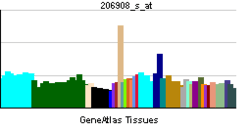CLDN11
Claudin-11 is a protein that in humans is encoded by the CLDN11 gene.[3][4][5] It belongs to the group of claudins.
The protein encoded by this gene belongs to the claudin family of tight junction associated proteins and is a major component of central nervous system myelin that is necessary for normal CNS function. There is growing evidence that the protein determines the permeability between layers of myelin sheaths via focal adhesion and, with its expression highly regulated during development, may play an important role in cellular proliferation and migration. In addition, the protein is a candidate autoantigen in the development of autoimmune demyelinating disease.[5]
References
Further reading
- Kniesel U, Wolburg H (2000). "Tight junctions of the blood–brain barrier.". Cell. Mol. Neurobiol. 20 (1): 57–76. doi:10.1023/A:1006995910836. PMID 10690502.
- Bronstein JM, Tiwari-Woodruff S, Buznikov AG, Stevens DB (2000). "Involvement of OSP/claudin-11 in oligodendrocyte membrane interactions: role in biology and disease.". J. Neurosci. Res. 59 (6): 706–11. doi:10.1002/(SICI)1097-4547(20000315)59:6<706::AID-JNR2>3.0.CO;2-D. PMID 10700007.
- Heiskala M, Peterson PA, Yang Y (2001). "The roles of claudin superfamily proteins in paracellular transport.". Traffic. 2 (2): 93–8. doi:10.1034/j.1600-0854.2001.020203.x. PMID 11247307.
- Tsukita S, Furuse M, Itoh M (2001). "Multifunctional strands in tight junctions.". Nat. Rev. Mol. Cell Biol. 2 (4): 285–93. doi:10.1038/35067088. PMID 11283726.
- Tsukita S, Furuse M (2003). "Claudin-based barrier in simple and stratified cellular sheets.". Curr. Opin. Cell Biol. 14 (5): 531–6. doi:10.1016/S0955-0674(02)00362-9. PMID 12231346.
- González-Mariscal L, Betanzos A, Nava P, Jaramillo BE (2003). "Tight junction proteins.". Prog. Biophys. Mol. Biol. 81 (1): 1–44. doi:10.1016/S0079-6107(02)00037-8. PMID 12475568.
- Shafit-Zagardo B, Kress Y, Zhao ML, Lee SC (1999). "A novel microtubule-associated protein-2 expressed in oligodendrocytes in multiple sclerosis lesions.". J. Neurochem. 73 (6): 2531–7. doi:10.1046/j.1471-4159.1999.0732531.x. PMID 10582615.
- Gow A, Southwood CM, Li JS, et al. (2000). "CNS myelin and sertoli cell tight junction strands are absent in Osp/claudin-11 null mice.". Cell. 99 (6): 649–59. doi:10.1016/S0092-8674(00)81553-6. PMID 10612400.
- Bronstein JM, Chen K, Tiwari-Woodruff S, Kornblum HI (2000). "Developmental expression of OSP/claudin-11.". J. Neurosci. Res. 60 (3): 284–90. doi:10.1002/(SICI)1097-4547(20000501)60:3<284::AID-JNR2>3.0.CO;2-T. PMID 10797530.
- Tiwari-Woodruff SK, Buznikov AG, Vu TQ, et al. (2001). "Osp/Claudin-11 Forms a Complex with a Novel Member of the Tetraspanin Super Family and β1 Integrin and Regulates Proliferation and Migration of Oligodendrocytes". J. Cell Biol. 153 (2): 295–305. doi:10.1083/jcb.153.2.295. PMC 2169454
 . PMID 11309411.
. PMID 11309411.
- Suzuki H, Fukunishi Y, Kagawa I, et al. (2001). "Protein–Protein Interaction Panel Using Mouse Full-Length cDNAs". Genome Res. 11 (10): 1758–65. doi:10.1101/gr.180101. PMC 311163
 . PMID 11591653.
. PMID 11591653.
- Strausberg RL, Feingold EA, Grouse LH, et al. (2003). "Generation and initial analysis of more than 15,000 full-length human and mouse cDNA sequences". Proc. Natl. Acad. Sci. U.S.A. 99 (26): 16899–903. doi:10.1073/pnas.242603899. PMC 139241
 . PMID 12477932.
. PMID 12477932.
- Liu F, Koval M, Ranganathan S, Fanayan S, Hancock WS, Lundberg EK, Beavis RC, Lane L, Duek P, McQuade L, Kelleher NL, Baker MS (2015). "A systems proteomics view of the endogenous human claudin protein family". J Proteome Res. doi:10.1021/acs.jproteome.5b00769. PMID 26680015.

 . PMID 11309411.
. PMID 11309411. . PMID 11591653.
. PMID 11591653. . PMID 12477932.
. PMID 12477932.